Eliza Knight's Blog, page 7
August 9, 2017
Cover Reveal: MY DEAR HAMILTON by Stephanie Dray & Laura Kamoie

From the New York Times bestselling authors of America’s First Daughter comes the epic story of Eliza Schuyler Hamilton—a revolutionary woman who, like her new nation, struggled to define herself in the wake of war, betrayal, and tragedy. Haunting, moving, and beautifully written, Dray and Kamoie used thousands of letters and original sources to tell Eliza’s story as it’s never been told before—not just as the wronged wife at the center of a political sex scandal—but also as a founding mother who shaped an American legacy in her own right.
We’re celebrating Eliza Schuyler Hamilton’s Birthday today and you get the gift! Don’t miss the beautiful cover below and a special giveaway, and don’t forget to pre-order your copy today!

About My Dear Hamilton: A Novel of Eliza Schuyler Hamilton (Coming 4.3.2018):
Wife, Widow, and Warrior in Alexander Hamilton’s Quest to Form a More Perfect Union
From the New York Times bestselling authors of America’s First Daughter comes the epic story of Eliza Schuyler Hamilton—a revolutionary woman who, like her new nation, struggled to define herself in the wake of war, betrayal, and tragedy. Haunting, moving, and beautifully written, Dray and Kamoie used thousands of letters and original sources to tell Eliza’s story as it’s never been told before—not just as the wronged wife at the center of a political sex scandal—but also as a founding mother who shaped an American legacy in her own right.
A general’s daughter…
Coming of age on the perilous frontier of revolutionary New York, Elizabeth Schuyler champions the fight for independence. And when she meets Alexander Hamilton, Washington’s penniless but passionate aide-de-camp, she’s captivated by the young officer’s charisma and brilliance. They fall in love, despite Hamilton’s bastard birth and the uncertainties of war.
A founding father’s wife...
But the union they create—in their marriage and the new nation—is far from perfect. From glittering inaugural balls to bloody street riots, the Hamiltons are at the center of it all—including the political treachery of America’s first sex scandal, which forces Eliza to struggle through heartbreak and betrayal to find forgiveness.
The last surviving light of the Revolution…
When a duel destroys Eliza’s hard-won peace, the grieving widow fights her husband’s enemies to preserve Alexander’s legacy. But long-buried secrets threaten everything Eliza believes about her marriage and her own legacy. Questioning her tireless devotion to the man and country that have broken her heart, she’s left with one last battle—to understand the flawed man she married and imperfect union he could never have created without her…
Pre-Order on Amazon | Barnes & Noble | GooglePlay | iBooks | Kobo
To celebrate Eliza Schuyler Hamilton’s Birthday today, we have a surprise for you! Share the cover of MY DEAR HAMILTON and fill out the Rafflecopter below to receive an Exclusive Excerpt!
Direct link: http://www.rafflecopter.com/rafl/display/5aedf95d1/?a Rafflecopter giveaway

New York Times bestselling author, Stephanie Dray is an award-winning, bestselling and two-time RITA award nominated author of historical women’s fiction. Her critically acclaimed series about Cleopatra’s daughter has been translated into eight different languages and won NJRW's Golden Leaf. As Stephanie Draven, she is a national bestselling author of genre fiction and American-set historical women's fiction. She is a frequent panelist and presenter at national writing conventions and lives near the nation's capital. Before she became a novelist, she was a lawyer, a game designer, and a teacher. Now she uses the stories of women in history to inspire the young women of today. Stephanie’s Website | Facebook | Twitter | Newsletter

New York Times bestselling author, Laura Kamoie has always been fascinated by the people, stories, and physical presence of the past, which led her to a lifetime of historical and archaeological study and training. She holds a doctoral degree in early American history from The College of William and Mary, published two non-fiction books on early America, and most recently held the position of Associate Professor of History at the U.S. Naval Academy before transitioning to a full-time career writing genre fiction as the New York Times bestselling author, Laura Kaye. Her New York Times bestselling debut historical novel, America's First Daughter, co-authored with Stephanie Dray, allowed her the exciting opportunity to combine her love of history with her passion for storytelling. Laura lives among the colonial charm of Annapolis, Maryland with her husband and two daughters.
Laura’s Website | Facebook | Twitter | Newsletter Sign-Up

Published on August 09, 2017 06:30
August 8, 2017
The Terror of South China
We’ve heard of Blackbeard, Captain Kidd, Calico Jack, and Henry Morgan—all famous for the piratical exploits and successful in their own ways. But who is the most successful pirate of all time? How about a captain of strength and courage who commanded a fleet of over 300 ships and, according to the varying resources, 20 to 40 thousand crewmen? This captain was also able to forge alliances with other pirate leaders, growing her control to over 1500 ships and 80 to 180 thousand pirates.
Her? Yes, her. Ching Shih must have been one hell of a woman.
 Ching Shih was born in 1775 in Guangdong, a province in southern China. Not much else is known about her other than she was a Cantonese prostitute with a floating brothel. Her business acumen must have started at a young age because she climbed the ranks quickly, apparently through her beauty and effective, sultry tête-à-têtes with the wealthy and social elite.
Ching Shih was born in 1775 in Guangdong, a province in southern China. Not much else is known about her other than she was a Cantonese prostitute with a floating brothel. Her business acumen must have started at a young age because she climbed the ranks quickly, apparently through her beauty and effective, sultry tête-à-têtes with the wealthy and social elite.
In 1801, she caught the eye of a notorious pirate, Cheng I, who proposed marriage. She agreed on one condition—that she have an equal share in his power and loot. Ah...true love. And so for the next six years, this tag team managed a proper piracy, leading a butt-kicking, scary powerful armada called the Red Flag Fleet. But then Cheng I died. Could have been by a tsunami or it could’ve been murder, no one knows for sure. At any rate, Ching Shih had to do some shrewd thinking and maneuvering to keep her place as the ruler among men.
What’s a savvy girl to do? She began a romantic relationship with Cheng I’s adoptive son and likely heir, Cheung Po Tsai. This while nurturing coalitions and existing loyalties, solidifying her authority with business and military strategies. Beyond making money the old-fashioned pirate ways of attacking ships, pillaging coastal towns, and outsmarting British, Portuguese and Chinese navies, she also dipped into blackmail, extortion, instituting levies, and even offered protection plans for those who provided supplies to her fleet.
But what about the monumental task of governing her growing number of pirates? Her answer to that is the code of conduct she wrote. It was quite harsh, even by pirate standards. By example, anyone who disobeyed an order lost their head, on the spot. Ouch! Ching Shih’s policy on female captives was infamous. Not-so-pretty women, to put it politely, were released unharmed. Attractive women were auctioned off to the crew as concubines. However, if a pirate outright purchased a prisoner, they were considered married and he was expected to care for her. And he better be faithful, lest he be executed by Ching Shih’s order.
 The Red Flag Fleet was unstoppable and Ching Shih’s moniker “The Terror of South China” had been well earned. She simply could not be defeated, not by China, Britain, Portugal, or the bounty hunters hunting her. In an effort to stop the hemorrhaging, in 1810 the Chinese government offered her, Cheung Po, and all pirates prowling under their command a deal too good to refuse. Leave the pirate life and receive global amnesty. But negotiations stalled in regards to what would happen to the reserve of booty as well as the fact the Chinese government wanted the pirates to kowtow before them. Ah, but remember, Ching Shih was a foxy woman. She negotiated an epic deal where most of her followers escaped any sort of punishment and got to keep their earnings. As for the kowtowing, it was solved in a simple matter. The government officially recognized the marriage of Ching Shih and Cheung Po and the two kneeled before them in thanks. Brilliant, really.
The Red Flag Fleet was unstoppable and Ching Shih’s moniker “The Terror of South China” had been well earned. She simply could not be defeated, not by China, Britain, Portugal, or the bounty hunters hunting her. In an effort to stop the hemorrhaging, in 1810 the Chinese government offered her, Cheung Po, and all pirates prowling under their command a deal too good to refuse. Leave the pirate life and receive global amnesty. But negotiations stalled in regards to what would happen to the reserve of booty as well as the fact the Chinese government wanted the pirates to kowtow before them. Ah, but remember, Ching Shih was a foxy woman. She negotiated an epic deal where most of her followers escaped any sort of punishment and got to keep their earnings. As for the kowtowing, it was solved in a simple matter. The government officially recognized the marriage of Ching Shih and Cheung Po and the two kneeled before them in thanks. Brilliant, really.
Ching Shih and Cheung Po retired from piracy with their riches and had a son together. Cheung Po went on to secure a comfy military post in the Qing Imperial Navy in the same year of their amnesty and Ching Shih opened a prosperous gambling house. Not bad for a couple of ruthless pirates.
The poor prostitute who took over the world as a formidable, wealthy pirate queen lived the rest of her days in peace, dying in 1844 from old age as a 69-year-old grandmother.
About the Author Jennifer is the award-winning author of the Romancing the Pirate series. Visit her at www.jbrayweber.com or join her mailing list for sneak peeks, excerpts, and giveaways.

Her? Yes, her. Ching Shih must have been one hell of a woman.
 Ching Shih was born in 1775 in Guangdong, a province in southern China. Not much else is known about her other than she was a Cantonese prostitute with a floating brothel. Her business acumen must have started at a young age because she climbed the ranks quickly, apparently through her beauty and effective, sultry tête-à-têtes with the wealthy and social elite.
Ching Shih was born in 1775 in Guangdong, a province in southern China. Not much else is known about her other than she was a Cantonese prostitute with a floating brothel. Her business acumen must have started at a young age because she climbed the ranks quickly, apparently through her beauty and effective, sultry tête-à-têtes with the wealthy and social elite.In 1801, she caught the eye of a notorious pirate, Cheng I, who proposed marriage. She agreed on one condition—that she have an equal share in his power and loot. Ah...true love. And so for the next six years, this tag team managed a proper piracy, leading a butt-kicking, scary powerful armada called the Red Flag Fleet. But then Cheng I died. Could have been by a tsunami or it could’ve been murder, no one knows for sure. At any rate, Ching Shih had to do some shrewd thinking and maneuvering to keep her place as the ruler among men.
What’s a savvy girl to do? She began a romantic relationship with Cheng I’s adoptive son and likely heir, Cheung Po Tsai. This while nurturing coalitions and existing loyalties, solidifying her authority with business and military strategies. Beyond making money the old-fashioned pirate ways of attacking ships, pillaging coastal towns, and outsmarting British, Portuguese and Chinese navies, she also dipped into blackmail, extortion, instituting levies, and even offered protection plans for those who provided supplies to her fleet.
But what about the monumental task of governing her growing number of pirates? Her answer to that is the code of conduct she wrote. It was quite harsh, even by pirate standards. By example, anyone who disobeyed an order lost their head, on the spot. Ouch! Ching Shih’s policy on female captives was infamous. Not-so-pretty women, to put it politely, were released unharmed. Attractive women were auctioned off to the crew as concubines. However, if a pirate outright purchased a prisoner, they were considered married and he was expected to care for her. And he better be faithful, lest he be executed by Ching Shih’s order.
 The Red Flag Fleet was unstoppable and Ching Shih’s moniker “The Terror of South China” had been well earned. She simply could not be defeated, not by China, Britain, Portugal, or the bounty hunters hunting her. In an effort to stop the hemorrhaging, in 1810 the Chinese government offered her, Cheung Po, and all pirates prowling under their command a deal too good to refuse. Leave the pirate life and receive global amnesty. But negotiations stalled in regards to what would happen to the reserve of booty as well as the fact the Chinese government wanted the pirates to kowtow before them. Ah, but remember, Ching Shih was a foxy woman. She negotiated an epic deal where most of her followers escaped any sort of punishment and got to keep their earnings. As for the kowtowing, it was solved in a simple matter. The government officially recognized the marriage of Ching Shih and Cheung Po and the two kneeled before them in thanks. Brilliant, really.
The Red Flag Fleet was unstoppable and Ching Shih’s moniker “The Terror of South China” had been well earned. She simply could not be defeated, not by China, Britain, Portugal, or the bounty hunters hunting her. In an effort to stop the hemorrhaging, in 1810 the Chinese government offered her, Cheung Po, and all pirates prowling under their command a deal too good to refuse. Leave the pirate life and receive global amnesty. But negotiations stalled in regards to what would happen to the reserve of booty as well as the fact the Chinese government wanted the pirates to kowtow before them. Ah, but remember, Ching Shih was a foxy woman. She negotiated an epic deal where most of her followers escaped any sort of punishment and got to keep their earnings. As for the kowtowing, it was solved in a simple matter. The government officially recognized the marriage of Ching Shih and Cheung Po and the two kneeled before them in thanks. Brilliant, really.Ching Shih and Cheung Po retired from piracy with their riches and had a son together. Cheung Po went on to secure a comfy military post in the Qing Imperial Navy in the same year of their amnesty and Ching Shih opened a prosperous gambling house. Not bad for a couple of ruthless pirates.
The poor prostitute who took over the world as a formidable, wealthy pirate queen lived the rest of her days in peace, dying in 1844 from old age as a 69-year-old grandmother.
About the Author Jennifer is the award-winning author of the Romancing the Pirate series. Visit her at www.jbrayweber.com or join her mailing list for sneak peeks, excerpts, and giveaways.

Published on August 08, 2017 01:30
August 1, 2017
THE WEALTHIEST MADAM IN THE WILD WEST by Kathleen Bittner Roth
THE WEALTHIEST MADAM IN THE WILD WESTBy Kathleen Bittner Roth
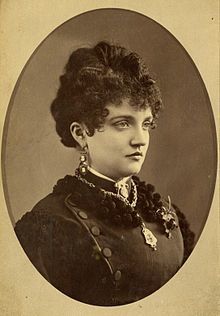
Mattie Silks was born Martha Ready in Pennsylvania 1845. High spirited and competitive, she had no inclination to work as a schoolmarm, considered the only respectable career for a woman during that era. Instead, Mattie knew a good opportunity when she saw it. She began her career as a madam in a rented flat in Springfield, Illinois where she took in twelve “Upstairs Girls.” Although considered a great beauty, she never resorted to prostitution herself. With a sharp business acumen, she expanded her “pleasure palaces” to include Dodge City, Kansas, and Denver, where she quickly became one of the best-known madams in the west. She took great pride in seeing that her girls were well taken care of. She even designed a Mattie Silks knife, which she gifted to her ladies to wear on their person on the streets of these wild towns.

Demand for women was highest in Denver, Colorado, due to the gold rush. Soon, Mattie’s expensive parlor houses made her fabulously wealthy. So accomplished was she as a madam, her reputation grew. Even the style of boot she wore bears her name. In Denver, she openly feuded with her competition, Kate Fulton and Jennie Rogers. Things got so bad between Mattie and Kate that they wound up in the only known pistol duel between two women. The fight, as it turned out, was not over money, but over a local businessman, Cortez Thomson, whom both women were seeing. When the day of the duel arrived, he stood off to one side, watching the battle take place. They both fired their pistols, but due to Mattie’s bad aim, Cortez got the bullet. He recovered, and ended up marrying Mattie three years later, and proceeded to lavishly spend her money. But such was love, for Mattie’s business continued to thrive, and her investments in real estate made her even wealthier, so she had little care as to how Thomson spent her money because she was having just as good a time spending it herself.
From 1877 to 1897 her brothel was the most successful in Denver. In 1898, Madam Jennie Rogers opened the House of Mirrorsand quickly became more successful than any of the competition. But then, Jennie Rogers died, and being the good business woman that Mattie was, she purchased the House of Mirrors for $14,000 and went on to make even more money.
Mattie Silks passed away in 1929 due to complications from a fall. She was buried beside the love of her life, Cortez Thomson, in the Fairmount Cemetery in Denver.
Kathleen Bittner Roth creates evocative stories featuring characters forced to draw on their strength of spirit to overcome adversity and find unending love. Her own fairy tale wedding in a Scottish castle led her to her current residence in Budapest, Hungary, considered one of Europe’s most romantic cities. A PAN member of Romance Writers of America®, Kathleen was a finalist in the prestigious Golden Heart® contest.
You can find Kathleen at:
Website: www.kathleenbittnerroth.comFacebook: facebook.com/Kathleen.bittnerroth.authorTwitter: @K_BittnerRothBook trailer: https://www.youtube.com/watch?v=GzWQNWFHvhUPinterest https://hu.pinterest.com/bittnerroth/Goodreads https://www.goodreads.com/author/show/7306082.Kathleen_Bittner_Roth


Mattie Silks was born Martha Ready in Pennsylvania 1845. High spirited and competitive, she had no inclination to work as a schoolmarm, considered the only respectable career for a woman during that era. Instead, Mattie knew a good opportunity when she saw it. She began her career as a madam in a rented flat in Springfield, Illinois where she took in twelve “Upstairs Girls.” Although considered a great beauty, she never resorted to prostitution herself. With a sharp business acumen, she expanded her “pleasure palaces” to include Dodge City, Kansas, and Denver, where she quickly became one of the best-known madams in the west. She took great pride in seeing that her girls were well taken care of. She even designed a Mattie Silks knife, which she gifted to her ladies to wear on their person on the streets of these wild towns.


Demand for women was highest in Denver, Colorado, due to the gold rush. Soon, Mattie’s expensive parlor houses made her fabulously wealthy. So accomplished was she as a madam, her reputation grew. Even the style of boot she wore bears her name. In Denver, she openly feuded with her competition, Kate Fulton and Jennie Rogers. Things got so bad between Mattie and Kate that they wound up in the only known pistol duel between two women. The fight, as it turned out, was not over money, but over a local businessman, Cortez Thomson, whom both women were seeing. When the day of the duel arrived, he stood off to one side, watching the battle take place. They both fired their pistols, but due to Mattie’s bad aim, Cortez got the bullet. He recovered, and ended up marrying Mattie three years later, and proceeded to lavishly spend her money. But such was love, for Mattie’s business continued to thrive, and her investments in real estate made her even wealthier, so she had little care as to how Thomson spent her money because she was having just as good a time spending it herself.

From 1877 to 1897 her brothel was the most successful in Denver. In 1898, Madam Jennie Rogers opened the House of Mirrorsand quickly became more successful than any of the competition. But then, Jennie Rogers died, and being the good business woman that Mattie was, she purchased the House of Mirrors for $14,000 and went on to make even more money.

Mattie Silks passed away in 1929 due to complications from a fall. She was buried beside the love of her life, Cortez Thomson, in the Fairmount Cemetery in Denver.
Kathleen Bittner Roth creates evocative stories featuring characters forced to draw on their strength of spirit to overcome adversity and find unending love. Her own fairy tale wedding in a Scottish castle led her to her current residence in Budapest, Hungary, considered one of Europe’s most romantic cities. A PAN member of Romance Writers of America®, Kathleen was a finalist in the prestigious Golden Heart® contest.
You can find Kathleen at:
Website: www.kathleenbittnerroth.comFacebook: facebook.com/Kathleen.bittnerroth.authorTwitter: @K_BittnerRothBook trailer: https://www.youtube.com/watch?v=GzWQNWFHvhUPinterest https://hu.pinterest.com/bittnerroth/Goodreads https://www.goodreads.com/author/show/7306082.Kathleen_Bittner_Roth

Published on August 01, 2017 00:00
July 11, 2017
The Rise and Fall of Port Royal
Port Royal was once a shining jewel of shipping and commerce in the Caribbean on the island of Santiago. Founded by the Spanish in 1518, the village was built on a sandy spit of land at the mouth of Kingston Harbor. Spain ruled over the island for nearly a hundred and fifty years before it was invaded by the English who took control in 1655 and renamed the island Jamaica. Soon Jamaica had become a chief sugar exporter. By the late 1600’s, Port Royal was one of the largest English cities outside of Europe. It was also known as the most “wicked and sinful city in the world”.
Here’s why.
Port Royal was a safe haven for privateers, buccaneers, and pirates. How did that happen? First, we must understand why the city was important. The harbor was large enough to receive many ships, upwards of five hundred or more. The waters were deep enough to anchor very close to the shore and bay acted as natural protection from angry tropical weather. The English didn’t have enough resources to protect their hold of Jamaica and it’s unofficial capital Port Royal. They were surrounded on all sides by an enemy with which they were at war, Spain. And so they turned to privateers and pirates to help defend the city.
 in some areas shallow enough ships could careen and make repairs. It proved an ideal outpost for trading goods with easy access to all the shipping lanes. And, because it sat on a long finger of land, the
in some areas shallow enough ships could careen and make repairs. It proved an ideal outpost for trading goods with easy access to all the shipping lanes. And, because it sat on a long finger of land, the
Situated in a sweet spot between the Spanish Main and the Atlantic, the location was perfect for, say, attacking ships laden with Spanish treasure and launching attacks on Spanish coastal towns. The pirates were pretty much given free sanction to pillage and plunder and the stolen goods would come through Port Royal. Pirates, merchants, and locals became stinkin’ rich, the Crown received a quarter of the gains, and the city was protected. It was a win for all involved. Well, except the Spanish. Yep, life was good in the booming port. Debauchery reigned as spoils were spent. Taverns and brothels were full and rowdy.
Even as the England and Spain drew a truce, Port Royal was the place to be to make a fast fortune. The seed had been planted. Craftsmen, slave traders, and entrepreneurs came in droves. The town rivaled cities like Boston and London. Its narrow streets and two thousand two-to-four story buildings crammed on just over fifty acres and boasted of a population of almost eight thousand. And while pirates were no longer needed, a former and notorious pirate captain, Henry Morgan, had been appointed the Lieutenant Governor. Over time, the port was no longer the sanctuary for pirates as it once was. Still, much to the displeasure of upstanding citizens, Port Royal had a reputation of being the “Sodom of the New World”. Drinking and prostitution were as rampant as ever. It had been estimated there was one tavern for every ten people. Wow. That’s a lot of partying.
 In 1692, busy Port Royal was arguably one of the wealthiest ports in the Caribbean. All that changed
In 1692, busy Port Royal was arguably one of the wealthiest ports in the Caribbean. All that changed
in a matter of minutes on June 7th in a trifecta of catastrophe. At approximately 11:43 in the morning, a massive earthquake rocked the island. The ground split, buildings crumbled. There was no place to hide from the destruction. No place safe. The earthquake was just the beginning. As the ground shook, the water-saturated sand beneath the city separated and became unstable, behaving like quicksand. This phenomenon is called liquefaction. Entire buildings sank straight down into the earth, taking everything and everyone with them. The earthquake shocks reportedly created liquefaction waves. With each passing wave, people became trapped in the ground as the sand solidified, crushing them to death. Unfortunately, that was not the end of it. The earthquake created a tsunami. As the tsunami rushed through Kingston Harbor, it bounced off the surrounding shores, sending multiple waves back to batter Port Royal.
Once the cataclysms subsided, two-thirds of the city (about thirty-three acres) had sunken beneath the sea and thousands of people lost their lives. The aftermath included a great many floating, decaying corpses and looting of homes, businesses, and bodies. No rest for the wicked. Many in the rest of the world felt that the destruction was divine intervention. But in all likelihood, being built on a sandy peninsula in an active fault zone doomed the port town from the beginning.
Though not completely swallowed up by the sea, Port Royal never regained her power and wealth.
About the Author
Jennifer is the award-winning author of the Romancing the Pirate series. Visit her at www.jbrayweber.com or join her mailing list for sneak peeks, excerpts, and giveaways.
Here’s why.
Port Royal was a safe haven for privateers, buccaneers, and pirates. How did that happen? First, we must understand why the city was important. The harbor was large enough to receive many ships, upwards of five hundred or more. The waters were deep enough to anchor very close to the shore and bay acted as natural protection from angry tropical weather. The English didn’t have enough resources to protect their hold of Jamaica and it’s unofficial capital Port Royal. They were surrounded on all sides by an enemy with which they were at war, Spain. And so they turned to privateers and pirates to help defend the city.
 in some areas shallow enough ships could careen and make repairs. It proved an ideal outpost for trading goods with easy access to all the shipping lanes. And, because it sat on a long finger of land, the
in some areas shallow enough ships could careen and make repairs. It proved an ideal outpost for trading goods with easy access to all the shipping lanes. And, because it sat on a long finger of land, theSituated in a sweet spot between the Spanish Main and the Atlantic, the location was perfect for, say, attacking ships laden with Spanish treasure and launching attacks on Spanish coastal towns. The pirates were pretty much given free sanction to pillage and plunder and the stolen goods would come through Port Royal. Pirates, merchants, and locals became stinkin’ rich, the Crown received a quarter of the gains, and the city was protected. It was a win for all involved. Well, except the Spanish. Yep, life was good in the booming port. Debauchery reigned as spoils were spent. Taverns and brothels were full and rowdy.
Even as the England and Spain drew a truce, Port Royal was the place to be to make a fast fortune. The seed had been planted. Craftsmen, slave traders, and entrepreneurs came in droves. The town rivaled cities like Boston and London. Its narrow streets and two thousand two-to-four story buildings crammed on just over fifty acres and boasted of a population of almost eight thousand. And while pirates were no longer needed, a former and notorious pirate captain, Henry Morgan, had been appointed the Lieutenant Governor. Over time, the port was no longer the sanctuary for pirates as it once was. Still, much to the displeasure of upstanding citizens, Port Royal had a reputation of being the “Sodom of the New World”. Drinking and prostitution were as rampant as ever. It had been estimated there was one tavern for every ten people. Wow. That’s a lot of partying.
 In 1692, busy Port Royal was arguably one of the wealthiest ports in the Caribbean. All that changed
In 1692, busy Port Royal was arguably one of the wealthiest ports in the Caribbean. All that changed in a matter of minutes on June 7th in a trifecta of catastrophe. At approximately 11:43 in the morning, a massive earthquake rocked the island. The ground split, buildings crumbled. There was no place to hide from the destruction. No place safe. The earthquake was just the beginning. As the ground shook, the water-saturated sand beneath the city separated and became unstable, behaving like quicksand. This phenomenon is called liquefaction. Entire buildings sank straight down into the earth, taking everything and everyone with them. The earthquake shocks reportedly created liquefaction waves. With each passing wave, people became trapped in the ground as the sand solidified, crushing them to death. Unfortunately, that was not the end of it. The earthquake created a tsunami. As the tsunami rushed through Kingston Harbor, it bounced off the surrounding shores, sending multiple waves back to batter Port Royal.
Once the cataclysms subsided, two-thirds of the city (about thirty-three acres) had sunken beneath the sea and thousands of people lost their lives. The aftermath included a great many floating, decaying corpses and looting of homes, businesses, and bodies. No rest for the wicked. Many in the rest of the world felt that the destruction was divine intervention. But in all likelihood, being built on a sandy peninsula in an active fault zone doomed the port town from the beginning.
Though not completely swallowed up by the sea, Port Royal never regained her power and wealth.
About the Author
Jennifer is the award-winning author of the Romancing the Pirate series. Visit her at www.jbrayweber.com or join her mailing list for sneak peeks, excerpts, and giveaways.
Published on July 11, 2017 01:30
July 4, 2017
A JULY 4TH THAT ALMOST WASN’T by Kathleen Bittner Roth
A JULY 4TH THAT ALMOST WASN’T
by Kathleen Bittner Roth

July 4th1776 didn’t start out as a holiday to be celebrated with family gatherings, picnics, and fireworks. Actually, it wasn’t until 1870, nearly a hundred years after the Declaration of Independence was written before Congress declared July 4th as a national holiday. And it wasn’t until 1939 and 1941 that further legislation regarding national holidays such as Christmas and Easter included July 4th as a day of celebrating the birth of the United States of America.
 Thomas Jefferson
Thomas Jefferson
In fact, July 4thwasn’t the day the Continental Congress declared Independence from Great Britain. The first draft was written by Thomas Jefferson back in June of that year, and declared on July 2nd. The document wasn’t delivered to a surprised British government until the following November.
Still, not much was done in the beginning about celebrating this important passage. In fact, around about 1790, the Declaration became controversial. Bitter conflicts arose between the Federalists, who opposed the Declaration as being too anti-British and backing the French, versus the Democrat-Republicans who were much in favor of Jefferson’s written document. The Declaration of Independence practically fell by the wayside as being questionable and/or of any value.
It wasn’t until the War of 1812 when things began to change. This was when the Federalist party came apart at the seams while new parties began forming who favored Jefferson and the questionable Declaration. By 1830 a revised document with the date July 4th, 1776 began to circulate. John Adams
John Adams
Perhaps it was the deaths of Thomas Jefferson and John Adams on July 4th 1826 that finally cemented the date as one to be celebrated by an entire nation. As we look back at history undressed, could it be that the deaths of these two men are the real reason we hang out our flags, fire up our grills, make the potato salads, and any other tasty potluck gems as we gather together with our friends and family to roast marshmallows and end our celebration by watching dazzling fireworks light the night sky in a land that remains free and independent of others?

Kathleen Bittner Roth creates evocative stories featuring characters forced to draw on their strength of spirit to overcome adversity and find unending love. Her own fairy tale wedding in a Scottish castle led her to her current residence in Budapest, Hungary, considered one of Europe’s most romantic cities. A PAN member of Romance Writers of America®, Kathleen was a finalist in the prestigious Golden Heart® contest.
You can find Kathleen at:
Website: www.kathleenbittnerroth.comFacebook: facebook.com/Kathleen.bittnerroth.authorTwitter: @K_BittnerRothBook trailer: https://www.youtube.com/watch?v=GzWQNWFHvhUPinterest https://hu.pinterest.com/bittnerroth/Goodreads https://www.goodreads.com/author/show/7306082.Kathleen_Bittner_Roth


July 4th1776 didn’t start out as a holiday to be celebrated with family gatherings, picnics, and fireworks. Actually, it wasn’t until 1870, nearly a hundred years after the Declaration of Independence was written before Congress declared July 4th as a national holiday. And it wasn’t until 1939 and 1941 that further legislation regarding national holidays such as Christmas and Easter included July 4th as a day of celebrating the birth of the United States of America.
 Thomas Jefferson
Thomas JeffersonIn fact, July 4thwasn’t the day the Continental Congress declared Independence from Great Britain. The first draft was written by Thomas Jefferson back in June of that year, and declared on July 2nd. The document wasn’t delivered to a surprised British government until the following November.
Still, not much was done in the beginning about celebrating this important passage. In fact, around about 1790, the Declaration became controversial. Bitter conflicts arose between the Federalists, who opposed the Declaration as being too anti-British and backing the French, versus the Democrat-Republicans who were much in favor of Jefferson’s written document. The Declaration of Independence practically fell by the wayside as being questionable and/or of any value.
It wasn’t until the War of 1812 when things began to change. This was when the Federalist party came apart at the seams while new parties began forming who favored Jefferson and the questionable Declaration. By 1830 a revised document with the date July 4th, 1776 began to circulate.
 John Adams
John Adams Perhaps it was the deaths of Thomas Jefferson and John Adams on July 4th 1826 that finally cemented the date as one to be celebrated by an entire nation. As we look back at history undressed, could it be that the deaths of these two men are the real reason we hang out our flags, fire up our grills, make the potato salads, and any other tasty potluck gems as we gather together with our friends and family to roast marshmallows and end our celebration by watching dazzling fireworks light the night sky in a land that remains free and independent of others?

Kathleen Bittner Roth creates evocative stories featuring characters forced to draw on their strength of spirit to overcome adversity and find unending love. Her own fairy tale wedding in a Scottish castle led her to her current residence in Budapest, Hungary, considered one of Europe’s most romantic cities. A PAN member of Romance Writers of America®, Kathleen was a finalist in the prestigious Golden Heart® contest.
You can find Kathleen at:
Website: www.kathleenbittnerroth.comFacebook: facebook.com/Kathleen.bittnerroth.authorTwitter: @K_BittnerRothBook trailer: https://www.youtube.com/watch?v=GzWQNWFHvhUPinterest https://hu.pinterest.com/bittnerroth/Goodreads https://www.goodreads.com/author/show/7306082.Kathleen_Bittner_Roth

Published on July 04, 2017 00:30
June 13, 2017
Dead Men Tell No Tales
It’s no secret Hollywood romanticizes and takes creative license when making movies. This is best witnessed in action or sci-fi movies but can be seen in everything from romantic comedies to horror to dramatic biopics. It’s all about evoking audience response—laughter, tears, heartbreak, wanting, fear, ire—and it’s entertainment. Of course, pirate movies are no different.
 As an author of pirate romance and someone who has researched in depth the pirate life, I can’t help but be critical when a television series or movie is based on pirate lore or has Caribbean pirate elements. Unless way off base, I don’t usually let fallacies get in the way of enjoying the feature. But when they get it right, the experience is more fulfilling.
As an author of pirate romance and someone who has researched in depth the pirate life, I can’t help but be critical when a television series or movie is based on pirate lore or has Caribbean pirate elements. Unless way off base, I don’t usually let fallacies get in the way of enjoying the feature. But when they get it right, the experience is more fulfilling.
Take the Pirates of the Caribbean franchise for example. It is fantastical and chock full of mythical creatures and nautical lore—the Kraken, fish people, Davy Jones, giant goddesses, man-eating sirens, Fountain of Youth, ghost sharks and skeletal undead pirates, to name a few. The plights of Captain Jack Sparrow and gang are always epic and the odds insurmountable. Each movie is an adventure with well-rounded endings. As a moviegoer, I am always blown away.
To be fair, I am a bit biased. I love the franchise, love Johnny Depp, sleep with a pillowcase of Will Turner, listen to the soundtracks while writing my own pirate tales, and even own an autographed copy of The Art of Pirates of the Caribbean—a collection of working drawings and conceptual art for the first three movies. I have waited with baited breath for the next movie Dead Men Tell No Tales to hit the silver screen. And I wasn’t disappointed. I laughed, cried, and thoroughly enjoyed being whisked away for more than 2 hours in a world that had captured my heart more than 13 years ago.
But how accurate is POTC? Some aspects are close, other aren’t. Okay, so that was an ambiguous answer. In part because it would depend on how much hair-splitting is involved. Think weapons, clothing, politics, tactics, superstitions, terminology and (most) settings*. The details are there, but they may not necessarily be right for the time period.
Pirate flavoring was added, and loads of it comes from what we already believe about pirates from Robert Louis Stevenson’s embellished adventure novel Treasure Island. In reality, there was no walking the plank or burying treasure. Eye-patches were not used to cover disfigurements, but rather to keep one eye adjusted to the darkness. Pirate codes were not universal; the articles varied from ship to ship. And there was no parlay nor swinging by ropes from ship to ship.
 What about those ships? The visual depictions of the variety of vessels are amazing and for the most part true. I say for the most part because I personally have not noticed anything erroneous. The makers even got the sails right. Unlike many seafaring movies which showcase vessels with tight square sails, POTC ships are closer to the truth with their billowing sails capturing the wind and fluttering to keep it. However, what is not quite right is the speed of the ships and size of ship to crew ratio. The Black Pearl, a ship that could even outrun the legendary Flying Dutchman, was a galleon. That size ship is too large to sail fast and maneuver with ease, assuming it isn’t resurrected by Davy Jones as the Black Pearl was. Add to that, it would require a sizeable crew numbering in the hundreds to man her, more depending also on how many guns she carried. Same holds true for the other ships in the films.
What about those ships? The visual depictions of the variety of vessels are amazing and for the most part true. I say for the most part because I personally have not noticed anything erroneous. The makers even got the sails right. Unlike many seafaring movies which showcase vessels with tight square sails, POTC ships are closer to the truth with their billowing sails capturing the wind and fluttering to keep it. However, what is not quite right is the speed of the ships and size of ship to crew ratio. The Black Pearl, a ship that could even outrun the legendary Flying Dutchman, was a galleon. That size ship is too large to sail fast and maneuver with ease, assuming it isn’t resurrected by Davy Jones as the Black Pearl was. Add to that, it would require a sizeable crew numbering in the hundreds to man her, more depending also on how many guns she carried. Same holds true for the other ships in the films.
Are Jack, Barbossa, Gibbs, and the rest true representations of pirates themselves? Not really. These are fictional characters with fictional quests. But some of their actions, motivations, goals, and methods were spot on. While sailors on both sides of the law often lacked education, pirates acted democratically, weighing risks, costs, and benefits, which determined which targets to pursue and what tactics were used. And though they might’ve been drunks, womanizers, and all-around rabble-rousers, they weren’t as bumbling as depicted in the movies. Sure makes for a great time, though, doesn’t it?
Like with most movies (and fiction in general), suspension of disbelief is a given to enhance the enjoyment. The runaway water wheel ending with the three-way swordfight in Dead Man’s Chest is definitely one of my favorites scenes. Some of those outlandish scenes in the latest POTC even seemed plausible though they weren’t, like using a rowboat as a makeshift submarine or a dagger upon a sail to slow a fall. Others aren’t so far-fetched. The green flash seen when “a soul comes back to this world from the dead” is a real occurrence. Not the soul coming back. The green flash. It is an “optical phenomena” that occurs just has the sun sets or rises upon the horizon. And there is more science behind several scenes in Dead Men Tell No Tales, one being the bootleg turn young Jack makes to escape Captain Salazar. See the bootleg turn at 0:27 in the trailer below. For more science at play, you'll just have to go see the movie.
Fact or fiction, Dead Men Tell No Tales is swashbuckling fun. Two thumbs up from this pirate wench.
(*Port Royal situated on a cliff in Curse of the Black Pearl was for the sake of cinema. Port Royal was actually built on a sandspit.)
About the Author Jennifer is the award-winning author of the Romancing the Pirate series. Visit her at www.jbrayweber.com or join her mailing list for sneak peeks, excerpts, and giveaways.
 As an author of pirate romance and someone who has researched in depth the pirate life, I can’t help but be critical when a television series or movie is based on pirate lore or has Caribbean pirate elements. Unless way off base, I don’t usually let fallacies get in the way of enjoying the feature. But when they get it right, the experience is more fulfilling.
As an author of pirate romance and someone who has researched in depth the pirate life, I can’t help but be critical when a television series or movie is based on pirate lore or has Caribbean pirate elements. Unless way off base, I don’t usually let fallacies get in the way of enjoying the feature. But when they get it right, the experience is more fulfilling.Take the Pirates of the Caribbean franchise for example. It is fantastical and chock full of mythical creatures and nautical lore—the Kraken, fish people, Davy Jones, giant goddesses, man-eating sirens, Fountain of Youth, ghost sharks and skeletal undead pirates, to name a few. The plights of Captain Jack Sparrow and gang are always epic and the odds insurmountable. Each movie is an adventure with well-rounded endings. As a moviegoer, I am always blown away.
To be fair, I am a bit biased. I love the franchise, love Johnny Depp, sleep with a pillowcase of Will Turner, listen to the soundtracks while writing my own pirate tales, and even own an autographed copy of The Art of Pirates of the Caribbean—a collection of working drawings and conceptual art for the first three movies. I have waited with baited breath for the next movie Dead Men Tell No Tales to hit the silver screen. And I wasn’t disappointed. I laughed, cried, and thoroughly enjoyed being whisked away for more than 2 hours in a world that had captured my heart more than 13 years ago.
But how accurate is POTC? Some aspects are close, other aren’t. Okay, so that was an ambiguous answer. In part because it would depend on how much hair-splitting is involved. Think weapons, clothing, politics, tactics, superstitions, terminology and (most) settings*. The details are there, but they may not necessarily be right for the time period.
Pirate flavoring was added, and loads of it comes from what we already believe about pirates from Robert Louis Stevenson’s embellished adventure novel Treasure Island. In reality, there was no walking the plank or burying treasure. Eye-patches were not used to cover disfigurements, but rather to keep one eye adjusted to the darkness. Pirate codes were not universal; the articles varied from ship to ship. And there was no parlay nor swinging by ropes from ship to ship.
 What about those ships? The visual depictions of the variety of vessels are amazing and for the most part true. I say for the most part because I personally have not noticed anything erroneous. The makers even got the sails right. Unlike many seafaring movies which showcase vessels with tight square sails, POTC ships are closer to the truth with their billowing sails capturing the wind and fluttering to keep it. However, what is not quite right is the speed of the ships and size of ship to crew ratio. The Black Pearl, a ship that could even outrun the legendary Flying Dutchman, was a galleon. That size ship is too large to sail fast and maneuver with ease, assuming it isn’t resurrected by Davy Jones as the Black Pearl was. Add to that, it would require a sizeable crew numbering in the hundreds to man her, more depending also on how many guns she carried. Same holds true for the other ships in the films.
What about those ships? The visual depictions of the variety of vessels are amazing and for the most part true. I say for the most part because I personally have not noticed anything erroneous. The makers even got the sails right. Unlike many seafaring movies which showcase vessels with tight square sails, POTC ships are closer to the truth with their billowing sails capturing the wind and fluttering to keep it. However, what is not quite right is the speed of the ships and size of ship to crew ratio. The Black Pearl, a ship that could even outrun the legendary Flying Dutchman, was a galleon. That size ship is too large to sail fast and maneuver with ease, assuming it isn’t resurrected by Davy Jones as the Black Pearl was. Add to that, it would require a sizeable crew numbering in the hundreds to man her, more depending also on how many guns she carried. Same holds true for the other ships in the films.Are Jack, Barbossa, Gibbs, and the rest true representations of pirates themselves? Not really. These are fictional characters with fictional quests. But some of their actions, motivations, goals, and methods were spot on. While sailors on both sides of the law often lacked education, pirates acted democratically, weighing risks, costs, and benefits, which determined which targets to pursue and what tactics were used. And though they might’ve been drunks, womanizers, and all-around rabble-rousers, they weren’t as bumbling as depicted in the movies. Sure makes for a great time, though, doesn’t it?
Like with most movies (and fiction in general), suspension of disbelief is a given to enhance the enjoyment. The runaway water wheel ending with the three-way swordfight in Dead Man’s Chest is definitely one of my favorites scenes. Some of those outlandish scenes in the latest POTC even seemed plausible though they weren’t, like using a rowboat as a makeshift submarine or a dagger upon a sail to slow a fall. Others aren’t so far-fetched. The green flash seen when “a soul comes back to this world from the dead” is a real occurrence. Not the soul coming back. The green flash. It is an “optical phenomena” that occurs just has the sun sets or rises upon the horizon. And there is more science behind several scenes in Dead Men Tell No Tales, one being the bootleg turn young Jack makes to escape Captain Salazar. See the bootleg turn at 0:27 in the trailer below. For more science at play, you'll just have to go see the movie.
Fact or fiction, Dead Men Tell No Tales is swashbuckling fun. Two thumbs up from this pirate wench.
(*Port Royal situated on a cliff in Curse of the Black Pearl was for the sake of cinema. Port Royal was actually built on a sandspit.)
About the Author Jennifer is the award-winning author of the Romancing the Pirate series. Visit her at www.jbrayweber.com or join her mailing list for sneak peeks, excerpts, and giveaways.
Published on June 13, 2017 01:00
June 6, 2017
New Release Spotlight: THE ALICE NETWORK by Kate Quinn

Craving stories about brave women of the past? Read about the unsung women who risked their lives as spies during World War I: The Alice Network is finally available for readers wherever books are sold! In an enthralling new historical novel from national bestselling author Kate Quinn, two women—a female spy recruited to the real-life Alice Network in France during World War I and an unconventional American socialite searching for her cousin in 1947—are brought together in a mesmerizing story of courage and redemption.
About The Book
1947. In the chaotic aftermath of World War II, American college girl Charlie St. Clair is pregnant, unmarried, and on the verge of being thrown out of her very proper family. She's also nursing a desperate hope that her beloved cousin Rose, who disappeared in Nazi-occupied France during the war, might still be alive. So when Charlie's parents banish her to Europe to have her "little problem" taken care of, Charlie breaks free and heads to London, determined to find out what happened to the cousin she loves like a sister.
1915. A year into the Great War, Eve Gardiner burns to join the fight against the Germans and unexpectedly gets her chance when she's recruited to work as a spy. Sent into enemy-occupied France, she's trained by the mesmerizing Lili, the "Queen of Spies", who manages a vast network of secret agents right under the enemy's nose.
Thirty years later, haunted by the betrayal that ultimately tore apart the Alice Network, Eve spends her days drunk and secluded in her crumbling London house. Until a young American barges in uttering a name Eve hasn't heard in decades, and launches them both on a mission to find the truth...no matter where it leads.
BUY THE ALICE NETWORKAmazon | Barnes & Noble | iTunes | Kobo
Advance Praise For "The Alice Network"“Amazing historical fiction... a must read!” (Historical Novel Society, Editor’s Choice)
“Lovingly crafted and brimming with details, readers are sure to be held in Quinn’s grip watching as the characters evolve. Powerful reading you can’t put down!” (RT Book Reviews (top pick))
“The Alice Network... perfectly balances a propulsive plot, faultlessly observed period detail, and a cast of characters so vividly drawn that I half expected to blink and see them standing in front of me. This is historical fiction at its best--thrilling, affecting, revelatory.” (Jennifer Robson, international bestselling author of Moonlight Over Paris)
“Both funny and heartbreaking, this epic journey of two courageous women is an unforgettable tale of little-known wartime glory and sacrifice. Quinn knocks it out of the park with this spectacular book!” (Stephanie Dray, author of America's First Daughter)
About The AuthorKate Quinn is a native of southern California. She attended Boston University, where she earned a Bachelor's and Master's degree in Classical Voice. A lifelong history buff, she has written four novels in the Empress of Rome Saga, and two books in the Italian Renaissance, before turning to the 20th century with "The Alice Network." All have been translated into multiple languages. Kate and her husband now live in Maryland with two black dogs named Caesar and Calpurnia, and her interests include opera, action movies, cooking, and the Boston Red Sox.
Kate's Website | Facebook Page | Twitter | Newsletter
Published on June 06, 2017 10:26
June 2, 2017
Séances, Spirits & Mediums - Victorians & Spiritualism
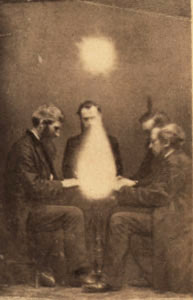 A Victorian seance - 1872Mediums and spirits and séances… oh, my! The image of proper Victorians gathered for séances to reach out to another realm has always intrigued me. Many Victorians were drawn to the notion that the living could communicate with those who’d passed beyond to another realm. Prominent Victorians such as Mary Todd Lincoln, Sir Arthur Conan Doyle, and Queen Victoria herself displayed a willingness to believe that spirits could send messages to those they’d left behind with the help of mediums who acted as intermediaries between the living and the dead. Séances were conducted in studios and parlors, all in the hope of establishing contact with the dead.
A Victorian seance - 1872Mediums and spirits and séances… oh, my! The image of proper Victorians gathered for séances to reach out to another realm has always intrigued me. Many Victorians were drawn to the notion that the living could communicate with those who’d passed beyond to another realm. Prominent Victorians such as Mary Todd Lincoln, Sir Arthur Conan Doyle, and Queen Victoria herself displayed a willingness to believe that spirits could send messages to those they’d left behind with the help of mediums who acted as intermediaries between the living and the dead. Séances were conducted in studios and parlors, all in the hope of establishing contact with the dead.During the nineteenth century, high child mortality rates and relatively short life expectancies made grief a prominent part of Victorian life. The Victorians employed elaborate mourning rituals, including black mourning dress, post-mortem photography, and the wearing of memento mori—jewelry that incorporated hair from the deceased. With grief such a part of life, it isn’t surprising to me that some Victorians sought contact with loved ones they’d lost. Sadly, in some cases, unscrupulous frauds exploited the despair of those mourning the dead.
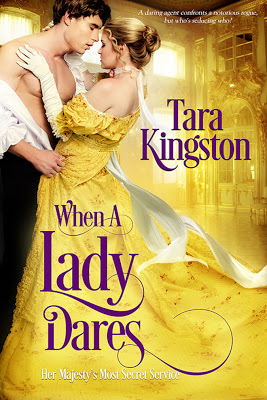 While some mediums may have genuinely believed in their abilities to reach out to the deceased, others were charlatans who played on the grief of the bereaved for monetary gain. A phony medium might also exert undue influence over someone in the throes of grief. This prospect intrigued me. What if a medium had exerted influence upon someone in a position of power—someone like the Queen? And what if those who knew too much had to be silenced?
While some mediums may have genuinely believed in their abilities to reach out to the deceased, others were charlatans who played on the grief of the bereaved for monetary gain. A phony medium might also exert undue influence over someone in the throes of grief. This prospect intrigued me. What if a medium had exerted influence upon someone in a position of power—someone like the Queen? And what if those who knew too much had to be silenced? What would happen if an undercover agent came too close to the conspiracy?
These questions provided inspiration for When A Lady Dares, the latest in my Victorian historical romance series, Her Majesty’s Most Secret Service. In When A Lady Dares, covert agent Sophie Atherton goes undercover as an assistant to a phony medium, a man who’s involved in more than simply extorting money from his clients. Swept into a treacherous scheme, she must unite with a notorious rogue with his own score to settle in order to survive the sinister plot.
While researching the story, I came upon a wealth of fascinating information about Victorians and their interest in communicating with spirits. Did you know:
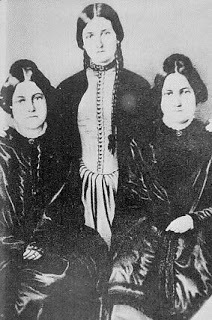 The Fox Sisters ~ The Spiritualist movement began in America. In 1848, sisters Leah, Kate and Margaret Fox claimed to communicate with a spirit in their home using knocks on wood. Over the years, the sisters established themselves as mediums, including conducting public demonstrations and séances.
The Fox Sisters ~ The Spiritualist movement began in America. In 1848, sisters Leah, Kate and Margaret Fox claimed to communicate with a spirit in their home using knocks on wood. Over the years, the sisters established themselves as mediums, including conducting public demonstrations and séances. ~ Forty years later (1888), Margaret Fox published a confession in the New York World that the rappings supposedly used by the dead to communicate during their séances had been produced by the sisters themselves using their fingers and feet.
~ Fake mediums employed tricks such as spirit photography, table rapping, and levitating objects with concealed wires. Mediums often claimed to have a relationship with a spirit guide in their communication with the spirit world.
~ Mediums frequently used accomplices to achieve the illusion of contact with the dead.
~ Queen Victoria was said to have had an interest in spiritualism, participating in séances before her husband’s death, and later, communicating with Prince Albert through séances.
~ It is said that a teenager, Robert James Lees, conveyed a message from Prince Albert to Queen Victoria and later conducted seances for the Queen at Windsor Castle.
~ Sir Arthur Conan Doyle, creator of Sherlock Holmes, was a proponent of spiritualism. In 1924, he published The History of Spiritualism, one of more than a dozen books he wrote on the subject.
To learn more about this topic:
http://www.victorianweb.org/victorian/religion/spirit.htmlhttp://www.victorianweb.org/victorian/authors/doyle/spiritualism.htmlhttp://www.bl.uk/romantics-and-victorians/articles/the-victorian-supernaturalhttps://en.wikipedia.org/wiki/Spiritualismhttps://en.wikipedia.org/wiki/Séance
All historical photographs are in the public domain.
About The Author:
Award-winning author Tara Kingston writes historical romance laced with intrigue, danger, and adventures of the heart. A Southern belle-out-of-water in a quaint Pennsylvania town, she lives her own love story with her real-life hero in a cozy Victorian. The mother of two sons, Tara's a former librarian whose love of books is evident in her popping-at-the-seams bookcases. It goes without saying that Tara's husband is thankful for the invention of digital books, thereby eliminating the need for yet another set of shelves. When she's not writing, reading, or burning dinner, Tara enjoys cycling, hiking, and cheering on her favorite football team.
Connect with Tara at www.tarakingston.com and on Facebook: https://www.facebook.com/AuthorTaraKingston
Author and History Undressed Contributor Kathleen Bittner Roth and I have partnered on a newsletter. If you'd like to subscribe, here's the link: Tara & Kathleen's Historical Romance Newsletter
SaveSave
Published on June 02, 2017 14:28
May 11, 2017
The Laird's Reckoning
Just in time for the release of the fifth Pirates of the Caribbean movie Dead Men Tell No Tales, I bring you my latest Romancing the Pirate novel. This tale veers slightly into uncharted waters for me. I’ve mixed pirates with Scottish Highlanders. A great deal of research went into making The Laird’s Reckoning, including watching the entire two seasons of Outlander. Nope, no hardship there. I enjoyed writing this story so much, I’m considering writing more Scottish pirate books.
The Laird’s Reckoning goes on sale May 30th at Amazon, but you can pre-order your copy today!
The Blurb:
Pirate or Laird...?
Birk Bane was born the second son, the unwanted son, the unneeded son. Crossed by family and falsely accused of a crime, he flees Scotland to the sea where he’s recruited by a pirate. Five years later, he’s captain of his own ship and embraces his new life, though an ache for the woman he left behind remains. When he receives word of his father’s death and his clan is floundering, Birk begrudgingly returns home. Little does he know there’s more he left behind than a title…much more.
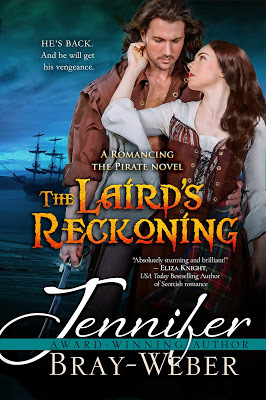 Sheena MacRae helped Birk escape to safety years ago, always expecting he’d return. Time passes and she believes him to be dead. With her clan being terrorized and slaughtered, she accepts she is the only one who can stop the suffering by agreeing to marry Laird Gordon, the man behind the assaults. The man who is also poised to rule Birk’s clan. Despite the crushing need to hold Birk in her arms once more, his reappearance changes nothing. Sheena has too much to lose if she reneges the betrothal to Gordon. And while Birk’s intentions are to return to the sea after reclaiming his clan, she didn’t count on her pirate lover’s plan for revenge…
Sheena MacRae helped Birk escape to safety years ago, always expecting he’d return. Time passes and she believes him to be dead. With her clan being terrorized and slaughtered, she accepts she is the only one who can stop the suffering by agreeing to marry Laird Gordon, the man behind the assaults. The man who is also poised to rule Birk’s clan. Despite the crushing need to hold Birk in her arms once more, his reappearance changes nothing. Sheena has too much to lose if she reneges the betrothal to Gordon. And while Birk’s intentions are to return to the sea after reclaiming his clan, she didn’t count on her pirate lover’s plan for revenge…
The longer he’s home, the more betrayal Birk uncovers. There will be a fiery battle ahead for Birk and his brethren. If he survives, how will he choose between the life he loves and the love of his life?
Enjoy this excerpt:
Don’t forget to pre-order your copy today!
Fair winds and following seas, mates!
About the Author Jennifer is the award-winning author of the Romancing the Pirate series. Visit her at www.jbrayweber.com or join her mailing list for sneak peeks, excerpts, and giveaways.
The Laird’s Reckoning goes on sale May 30th at Amazon, but you can pre-order your copy today!
The Blurb:
Pirate or Laird...?
Birk Bane was born the second son, the unwanted son, the unneeded son. Crossed by family and falsely accused of a crime, he flees Scotland to the sea where he’s recruited by a pirate. Five years later, he’s captain of his own ship and embraces his new life, though an ache for the woman he left behind remains. When he receives word of his father’s death and his clan is floundering, Birk begrudgingly returns home. Little does he know there’s more he left behind than a title…much more.
 Sheena MacRae helped Birk escape to safety years ago, always expecting he’d return. Time passes and she believes him to be dead. With her clan being terrorized and slaughtered, she accepts she is the only one who can stop the suffering by agreeing to marry Laird Gordon, the man behind the assaults. The man who is also poised to rule Birk’s clan. Despite the crushing need to hold Birk in her arms once more, his reappearance changes nothing. Sheena has too much to lose if she reneges the betrothal to Gordon. And while Birk’s intentions are to return to the sea after reclaiming his clan, she didn’t count on her pirate lover’s plan for revenge…
Sheena MacRae helped Birk escape to safety years ago, always expecting he’d return. Time passes and she believes him to be dead. With her clan being terrorized and slaughtered, she accepts she is the only one who can stop the suffering by agreeing to marry Laird Gordon, the man behind the assaults. The man who is also poised to rule Birk’s clan. Despite the crushing need to hold Birk in her arms once more, his reappearance changes nothing. Sheena has too much to lose if she reneges the betrothal to Gordon. And while Birk’s intentions are to return to the sea after reclaiming his clan, she didn’t count on her pirate lover’s plan for revenge…The longer he’s home, the more betrayal Birk uncovers. There will be a fiery battle ahead for Birk and his brethren. If he survives, how will he choose between the life he loves and the love of his life?
Enjoy this excerpt:
“They’re coming!”The panic in Sheena’s eyes matched Birk’s racing heart. Their breaths stirred the dust they had kicked up crouching behind the crates. Shouts carried down the alleys, drawing closer.Sheena gripped his arms. “Go!” Her pleading command rushed out in a hoarse whisper. “Run, before they catch you.”“Come with me.” It was a desperate attempt to keep Sheena by his side, a selfish one. But he was no fool. If the magistrate found out she helped him escape, his bonny lass would be imprisoned. He couldn’t protect her if he left her behind.She shook her head, mahogany tresses slipping free from the knot at her crown. “I canna leave my father and Mallabroch Manor.” Gruff voices neared. Her eyes widened, begged. “Please, Birk. If ye are hanged, I’ll kill myself, I swear I will.”He believed it. By the heavens, he loved his lass. Loved her more than anything this world had to offer. He’d give his life for her. But never would he allow her to give hers for him. Never. “I canna leave you.” He could hardly swallow, the lump of fear wedged tight in his throat. She was his air, the beat of his heart. He was terrified to be without her. Terrified and angry. Angry for the pain marring her beautiful effervescent smile. He swore whoever set him up, accused him of being a false coiner, would pay and pay dearly.“Ye must go.” She grabbed his face with both hands. “Ye must. For me.”The tears cresting in those moss green eyes, the tremble in her bottom lip, tore at his soul. What choice did he have? Sheena would not leave her father, her home. This he knew. Her love and loyalty for her da was fierce. Could he really expect her to leave Ramsay, the laird of Mallabroch, alone, as ill as he was? Would he be able to protect her any better on the lam? No. He had no choice. She was a mighty one. She’d be fine, if only he’d let her go. Let her go and run. Damn it, he never ran from anything. He tucked a wayward lock behind her ear. “For you,” he repeated.A shaky smile accompanied her gusty breath of relief. “I love you, Birk.”“And I you. More than the moon and stars.” He pressed a kiss to her mouth. “I will clear my name,” he vowed against her lips. “I will come back for you.”Birk gripped the back of her neck and she deepened the kiss. For a moment, he lost himself with her. The accusations, the magistrate’s guard closing in, his damaged, jaded world faded into the light, musky, floral scent of heather and urgent caress of her lips.“This way!” The strident shout broke the haze, yanking him back to the present. “Promise me.” She choked on the words.Footfalls pounded against the packed dirt.He could take no more of her agony. Aye. He would see the man who framed him dead. “I promise, mo teine, my fire. I will return for you.”“Back here! This way!”Tears streamed down her creamy, flushed cheeks. She nodded once. Without a word, she spun to stand, ready to face the men chasing after him.Birk took off at a run, dodging barrels and crates, cutting around the buildings on the leading edge the rest of the way through the town to the docks. Behind him, he heard her shrill scream. He pushed hard against the urge to hasten back to her. He had to believe she would be all right. She was a hellcat when provoked. Sheena would be fine. She had to be.He jumped over a pile of ropes and looped through stacks of lumber. The stench of timber and pitch mixed with brine. Off to the left, a carpenter hammered, the thudding so familiar. Ahead, several stevedores unloaded cargo from a ship. Birk hadn’t thought beyond fleeing the cell which Sheena unlocked. He hadn’t thought to where he’d go. But Sheena had. He was to flee to the only place he’d known—his father’s shipyard. Now as he skidded to a stop in the middle of the yard, realization struck. He had trapped himself between the town and the men coming for him and the sea. Bloody hell. Aye, there was a boat waiting for him somewhere, but would he reach it in time?Sheena’s plan. Take a skiff across the Sound of Sleat to the mainland. Find a horse in Mallabroch and disappear. It was his only option, though he would rather have her by his side. Running from all the injustices their young lives had suffered, together.Birk slunk through the maze of planks, boxes, casks, and tools, weaving through the scaffolding beneath the hull of a brigantine. He set his sights to the end of the docks where fishermen cast out in their skiffs. Just as he cleared the last support beam, he came face to face with his father.Bewilderment flashed across his haggard face but was soon replaced with a flare of venom.Birk slid his gaze past his father to his cousin rounding the other side of the scaffolding and coming up short. Cam slowly took a step back, as if he hoped not to become entangled in a confrontation.“Birk.” A sneer crooked his father’s mouth. “Let ye out, did they?” His tone belied he knew the better.Shouts traveled through the shipyard. His pursuers were nearly upon him.“Hmph.” The old man lifted his chin and sneered down his nose. “Suppose not.”“I didna do it, Father.” Speaking truths, hell, speaking at all was lost on the man.Since birth, Hugh Bane, laird of Creaganbroch Manor, the village of Tradale, and the surrounding lands, had shunned his youngest son—the weak, sickly child who wasn’t expected to live. But his mother refused to accept her little bairn could not grow happy and healthy. Through her love and nurturing, never leaving his side, Birk survived the infant months to become the favorite of her three sons. That didn’t change as he grew a few years older. Hugh had become resentful, claiming his wife mollycoddled Birk. He’d force Birk into harsh labor around the yard, harsher than he should have for a boy his age. This but angered his mother and many fights were waged over Birk. Until his mother fell ill with fever. Upon her final breaths, it wasn’t Hugh she called for, but Birk. And Birk had suffered for it ever since.Except that he didn’t. He hadn’t let the old man get the better of him. Not after the last time he took a backhand across his face at the age of fifteen.“Didna do it?” Hugh spat. “’Tis your fault I’ve buried James. Ye and your goddamned defiance.”And there it was. The blame he’d been burdened with and the guilt that his father was right this time. But that was his cross to bear and he’d be damned to let the old man lay one more thing at his feet. He’d be damned to give him any such satisfaction.A wicked grin crooked one side of Cam’s mouth. One day, Birk would bloody up that idiot’s face, the toady.“I didna kill James.”“Ye did, and ye sullied the Bane name with your thievery.” Hugh, quick as a viper, snatched Birk’s arm. “Cam.”“Yes, uncle?”His father’s expression hardened. “Alert the authorities in the yard,” he leaned within an inch of Birk’s face, his eyes darkened with hate, “we have the bastard here.”Birk had never gotten along with his cousin, but something about the toothy grin splitting Cam’s face didn’t set right with him. ’Twas more than Birk facing certain death at the end of a rope. ’Twas something…triumphant. Cam spun on his heel toward the approaching men.“May ye rot in hell,” Hugh spewed.Birk wrenched his arm free and leaned in even further, a hair’s breadth from the man. “Ye first.”If ye haven't signed up FOR MY NEWSLETTER for sneak peeks, excerpts, and giveaways, what are you waiting for? All new subscribers will have a chance to win a signed print copy of The Laird's Reckoning!
Don’t forget to pre-order your copy today!
Fair winds and following seas, mates!
About the Author Jennifer is the award-winning author of the Romancing the Pirate series. Visit her at www.jbrayweber.com or join her mailing list for sneak peeks, excerpts, and giveaways.
Published on May 11, 2017 04:00
May 2, 2017
Dream a Little Dream by Kathleen Bittner Roth
DREAM A LITTLE DREAMby Kathleen Bittner Roth
Dream researchers report that our dreams might be our greatest untapped resource connecting us to our subconscious and inner knowing. Think of nightmares as an overblown shout-out from your subconscious screaming at you to pay attention.

Elias Howe (1819-1867), inventor of the sewing machine, couldn’t figure out how to get the threads to lock together. He had a nightmare that he was forced to build a sewing machine for a savage king. He thought the king had given him twenty-four hours in which to complete the machine. Should he not complete his project, death would be his punishment. In the dream, Howe failed. He thought he was being taken out to a courtyard to be executed. Before him stood a cadre of soldiers dressed in crisp red uniform jackets, white slacks and tall fur hats. They paraded single file past him, each carrying a long, thin spear. In rhythmic precision, they proceeded to stab him, one after the other. Terrified as he was, he noted a hole at the end of each spear. He had his answer! In the middle of the night in 1846, Howe awoke from the nightmare and rushed to his laboratory where he quickly created a working machine. The nightmare with all its horror was his subconscious screaming the answer at him.

Howe is not the only person who’s dreamed solutions to a problem. Dream researchers say people who experience déjà vu most likely experienced a precognitive dream which is why whatever they currently confront seems familiar. These researchers say there are certain symbols that indicate a person is experiencing a precognitive dream (one of them is if the dream contains three round circular objects of some kind). I paid close attention to those symbols thereafter, and since I keep a dream journal, I can recount three precognitive dreams that led to my move to Europe.
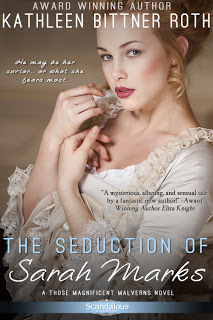
Everyone dreams, even though some think they don’t. They simply don’t recall. However, they can train themselves to remember. One night, I dreamed THE SEDUCTION OF SARAH MARKS in its entirety. It was like watching a movie. Although I’ve dreamed bits and pieces of other stories, I’ve never before or since had the pleasure of having an entire story unfold from start to finish. Thus, when Sarah’s story ended up being my debut novel, it held a special meaning to me. Was it destiny? I don’t know, but it’s fun to think it was. I once read that Danielle Steele often dreams her books.I happen to be particularly interested not only in my dreams, but in those of others. Having spent years teaching a dream recall seminar in a wellbeing center that I founded, I’m used to paying close attention to my dreams, and do so in a particular manner that I’ve taught others with some good results.We dream in symbols, some archetypal, others personal interpretations that we have to learn to decipher, so if you want to start paying attention to your dreams and how your subconscious is speaking to you, the first and most important thing to do is keep a journal and pen by your bed because you only have about ten minutes to recall everything correctly. You may want to keep a small flashlight as well. In your journal, quickly note the colors, symbols, feelings, and content.After a while, you’ll likely notice a recurring theme. Also, when you slip off into that space between wakefulness and sleep, it’s an indication that your brain cycle has dropped into what’s called the theta level. Here is where your conscious and subconscious overlap; the perfect time to repeat an affirmation or “send a message”, if you will. Twenty-one days is how long it takes to create a new habit, so if you use a simple affirmation like, “Easily and effortlessly, I remember my dreams. My dreams give me insight into the direction of my life,” and keep a daily journal (even if you think you got nothing) something is bound to happen. After the twenty-one day period ends, you can give yourself other directives. I like to start with, “Show me what I need to know about such and such.” I get lots of answers to various questions that way.I do not plot, I write by the seat of my pants, and often use this method for helping me write my stories. When I wrote A DUKE’S WICKED KISS which has a lot of conflict in it, I would often go to bed and drift off with affirmations something like: “Show me what happens next to Ravenswood.” Or, “Is now the time for such and such to happen?” Learning to trust yourself is a vital aspect of dream recall. Your intuition is always 100% correct, it’s never wrong. You just have to learn the difference between intuitive feelings and human emotion. Like building a muscle in a gym, you don’t go in the first time and expect to walk out pumped up. It takes time, effort and consistency, but there is always a payoff.What about you, do you recall dreams? Or have you had an experience or result by following the directive in a dream? I’d love to hear from you.

While on a secret mission for the Crown, a proper duke falls for an improper daughter of an Indian royal and British noble. Miss Suri Thurston knows the pain of abandonment. Intent on confronting the grandmother who tossed her to the lions, she travels from England to her birthplace in India. Her plans run afoul when she encounters the man who, ten years prior, left a mark on her soul with one stolen kiss. But he is a duke, and far beyond the reach of even her dreams.The Duke of Ravenswood, secret head of the British Foreign Service, has no time for relationships. His one goal is to locate and eliminate key insurgents involved in an uprising against the British East India Company before it's too late. But when Suri appears in Delhi, his resolve is tested as he finds his heart forever bound to her by the one haunting kiss they shared once upon a time. With Suri's vengeful Indian family looking for her death, and insurgents intent on mutiny tearing their world apart, can their love rise above the scandal of the marriage they both desperately want?
Read it now!
Kathleen Bittner Roth creates evocative stories featuring characters forced to draw on their strength of spirit to overcome adversity and find unending love. Her own fairy tale wedding in a Scottish castle led her to her current residence in Budapest, Hungary, considered one of Europe’s most romantic cities. A PAN member of Romance Writers of America®, Kathleen was a finalist in the prestigious Golden Heart® contest.
You can find Kathleen at:
Website: www.kathleenbittnerroth.comFacebook: facebook.com/Kathleen.bittnerroth.authorTwitter: @K_BittnerRothBook trailer: https://www.youtube.com/watch?v=GzWQNWFHvhUPinterest https://hu.pinterest.com/bittnerroth/
Goodreads https://www.goodreads.com/author/show/7306082.Kathleen_Bittner_Roth
Published on May 02, 2017 00:00



